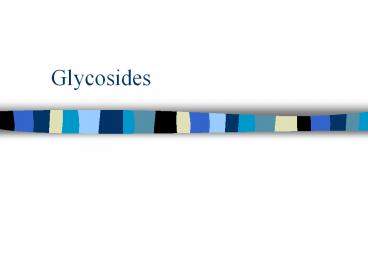Glycosides - PowerPoint PPT Presentation
1 / 29
Title:
Glycosides
Description:
Glycosides Glycosides Secondary products formed from one or more sugar molecules added to a non-sugar biologically active molecule Sugar most commonly found is ... – PowerPoint PPT presentation
Number of Views:824
Avg rating:3.0/5.0
Title: Glycosides
1
Glycosides
2
Glycosides
- Secondary products formed from one or more sugar
molecules added to a non-sugar biologically
active molecule - Sugar most commonly found is glucose
- Non-sugar molecule known as the aglycone and may
be - amino acid derivatives
- steroids
- triterpenes
3
Glycosides
- Most common types
- Saponins
- Cardiac Glycosides (Cardenolides)
- Cyanogenic Glycosides
- Anthraquinone Glycosides
- Glucosinolates - technically not glycosides
- Most glycosides function as deterrents to
herbivores
4
Saponins
- Terpene glycosides
- Steroid glycosides
- Steroid-alkaloid glycosides
- Triterpene glycosides
- May also occur as the aglycone and are called
sapogenins
5
Properties of Saponins
- Combination of hydrophobic terpene with a
hydrophillic sugar produces cmpds that act as
surfactants (detergents) - When agitated in water, saponins form a soapy
lather
6
Effects of saponins on animals
- Variable effects
- Highly toxic to fish - used as fish poison
- Not significantly toxic to mammals
- Have a bitter acrid taste and cause severe
gastric irritation if ingested - Implicated in livestock poisoning - alfalfa
- Will hemolyze red blood cells if injected into
blood stream - because of the detergent properties
7
Useful saponins
- Saponins from yam - Disocorea spp. are the source
of steroids used for human hormones - Birth control pills - most synthetic but some
still use natural hormones - Anti-inflammatory steroids
- Licorice - Glycyrrhiza glabra produces saponins
that possibly help gastric ulcers because they
suppress prostoglandins
8
Cardiac glycosides
- Structurally similar to saponins with similar
detergent properties - Distinguished by presence of a lactone ring and
rare sugars - Wide distribution - found in over 200 species (55
genera in 12 families) - Best known are digitoxin and digoxin from
Digitalis (foxglove) 30 glycosides
9
(No Transcript)
10
Digitoxin
11
Sugars in digitoxin
- 2 molecules of digitose
- 1 molecule of 1-acetyl digitose
- 1 molecule of glucose
Digitose
12
Action of Cardiac Glycosides
- In medicinal doses, cardiac glycosides increase
the contractions of heart and the force of the
heart beat - Increases cardiac output
- Improved circulation, decreases edema, and
increases kidney output - Most effective for congestive heart failure
- Toxic doses cause arrhythmias or even cardiac
arrest fine line between medicinal and toxic
13
Poisonous Plants with Cyanogenic Glycosides
- Foxglove - Digitalis purpurea
- Oleander - Nerium oleander
- Lily of the Valley - Convallaria sp.
- Milkweed - Asclepias spp
14
Oleander
15
Oleandrin
16
Milkweeds
- Another common source of glycosides are milkweeds
- produce latex rich in cardiac glycosides - Milkweed leaves host for monarch butterfly larvae
- Glycosides sequestered in body of larvae and
retained through metamorphosis and present in
butterfly - Butterflies toxic to birds that feed on them
causing vomiting - birds avoid butterflies
17
Cyanogenic glycosides
- About 150 spp of plants produce glycosides that
release hydrogen cyanide - HCN - Most cyanogenic glycosides are derived from 4
amino acids (phenylalanine, tyrosine, valine, or
isoleucine) or from nicotinic acid - Cyanogenic glycosides are not toxic by themselves
but when a plant is damaged by an herbivore,
glycoside is broken down by enzymes and HCN is
released
18
Breakdown of cyanogenic glycosides
- Two enzymes involved
- b-glycosidase releases the sugars
- Hydroxynitrile lyase releases HCN
- Does not occur in intact plants because enzymes
and substrates spatially separated (i.e.
glycoside in epidermis and enzymes in mesophyll) - Only when cells crushed are they brought together
19
Effects of HCN
- HCN inhibits ETS
- HCN completely inhibits the transfer of electron
to oxygen by cytochrome oxidase final step in
the ETS - This can lead to cell death and possibly even the
death of the organism if the concentration is
high enough
20
Electron Transport System
21
HCN- Glycoside variability
- Amounts of cyanogenic glycosides highly variable
in any one species - Control of variability both genetic and
environmental - Cassava (Manioc esculenta) major food crop with
cyanogenic glycosides - Rosaceae (Rose Family) contains cyanogenic
glycoside - amygdalin
22
Cassava glycosides
- Traditional preparation removes toxins usually
- In Africa reported cases of cassava paralysis due
to HCN poisoning the motor region of brain
23
Cassava
24
(No Transcript)
25
(No Transcript)
26
Amygdalin
- Found in seeds, stems, leaves and roots of
apricots, cherries, peaches, apples, almonds -
bitter almond - Acute poisoning has occurred when young children
have eaten apricot pits - Laetrile - controversial cancer treatment
27
Laetrile
- Apricot pits are rich in amygdalin
- Ground up for preparation of laetrile, a
controversial cancer treatment - Theoretically, laetrile releases HCN only in the
presence of tumor cells and selectively destroys
them - Not proven and laetrile not approved for cancer
therapy in the United States
28
Amygdalin
29
Glucosinolates
- Sulfur and nitrogen containing cmpds in the
mustard family - Provide flavor of cabbages, broccoli,etc
- Feeding repellants and insect toxins
- Provide the potency of mustard and horseradish
antibiotic properties of these - Rape seed development































